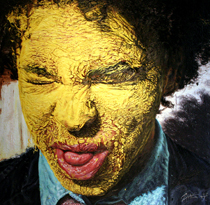Alfred Hitchcock: The Complete Films
By Paul Duncan
New York, New York: Taschen, 2011
192 pp. $16.99
Rightly, Benedikt Taschen celebrates his first quarter-century of publishing books on art, comics, photography, and cinema by releasing Paul Duncan’s Alfred Hitchcock: The Complete Films. In the packaging of this book, Taschen, the great marketer of visual arts pays homage to Hitchcock, the great marketer of himself (the “world’s most famous profileâ€), his films, and cinema itself as an art form of psychological complexity as well as visceral entertainment.
Duncan surveys Hitchcock’s films, providing a synopsis of, commentary on, and biographical insights into each. He also notes recurrent themes and styles. However, this book is a photo compilation, featuring stills from the dozens of productions, publicity pix, and also personal shots of Hitchcock alongside his actors, his production team, or his wife and collaborator Alma Reville. The snaps both elucidate Duncan’s accessible – or pedestrian – commentary, while also limiting his profound or impressive analyses to a statement or two. Because the photos dominate, the author is pushed toward aphorism.
Still, The Complete Films accomplishes what the subtitle indicates – to give us overviews and inside-takes on the successes or drawbacks of each title, while also judiciously employing quotations from Hitchcock and his associates, or from savvy critics. Discussing Vertigo (1958), Duncan sees that the film is a “gothic romance†between Scottie Ferguson (James Stewart) and Madeleine Elster/Judy Barton (Kim Novak), in which a “cycle of love and death intertwined†is repeated.
That’s an ordinary reading, but Duncan goes on to notice, “The key to this extraordinary film is when Scottie and Madeleine visit the sequoias†and “we learn that sequoia translates as ‘always green, everlasting.’†So, both Madeleine and Judy (the same woman, anyway) appear “wearing green and in profile.†Madeleine “drives a green car and green from a neon light bathes Judy when she is transformed back into Madeleine.†Hitchcock uses the sequoia/green connection to make the point that Scottie’s desired women “are objects of love, remade, over and over.†Eyeing The Birds (1963), Duncan insists the film suggests, “The characters are attacked by birds for no apparent reason and it irrevocably changes them.†This simplistic thought accords with Hitchcock’s own (mis)direction that “The ambiguity of the film’s meaning is a prime virtue.†Yes, but… In my opinion, those Birds characters guilty of either sexual indiscretion or repression – the typical moral problems in horror films – are those most fearful of these avian angels of retribution. Tellingly, the scene in which Melanie Daniels (Tippi Hedren) “undergoes an ordeal trapped in a room of attacking birds,†looks, to my eyes, a lot like St. Sebastian being pierced – erotically, even ecstatically – by phallic arrows.
Maybe Duncan doesn’t do enough with the church-going Hitchcock’s Catholicism, a faith that would have taught him about the lives and deaths of saints, the psychological consequences of sin, and even, as in the Book of Job, the jests and whims of divinity. At least Duncan remembers Hitchcock’s I Confess (1953), the auteur’s only film made in Canada in Ville de Québec, including a scene shot – miraculously – inside the Assemblée nationale. (There is a fake Halifax, N.S., scene in Hitchcock’s The 39 Steps [1935]; it also includes fake Mounties.) I Confess centres on the obligations of priests. The atmospheric opening shots of the looming, brooding Château Frontenac establish that, even in the mid-20th-century, humans are feudal beings, driven by lust, love, and greed, and capable of treachery and murder – as well as transcendent acts of trust and forgiveness. It is, I think, a deeply Catholic film, and that is why Hitchcock shot it in North America’s most medieval-looking city and lit it as if one is always inside a cathedral.
Although it is possible to question Duncan’s interpretations, or even to quibble –though less often – with Hitchcock’s own provisos regarding his films and filmmaking, this book reminds us that, to a large extent, Hitchcock invented the way we see and understand cinema. For instance, as Sinclair McKay suggested in 2010, every Bond film takes its style from Hitchcock’s North by Northwest (1959).






Hi Professor Clarke,
It’s been a long time since Modern Canadian Poetry! I wanted to ask you a question about your opening line- perhaps it’s more about defining mystical and intellectual from a poetic perspective-
How do you define the poetry of Rumi, Hafez and other sufi poets? They defy the ‘intellectual’ term– would you call them ‘mystical’ or ‘sentimental’- or are they accessible enough to not be defined as either ‘intellectual’ or ‘mystical’, despite being rooted in a mystical tradition?
Hope you’re doing really well!